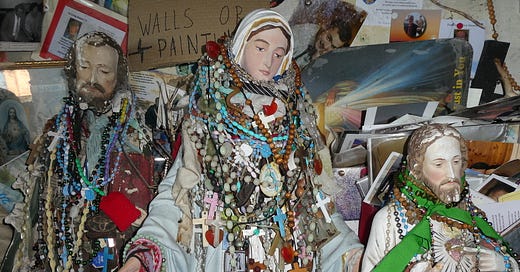St Bridget’s Well, Ballysteen, County Clare
If you keep driving south along that Wild Atlantic Way that we heard about last week, eventually you’ll reach the ‘world-famous Cliffs of Moher’. I recommend that you keep driving. These great black cliffs, home to countless seabirds, are now scarred with a hideous tourist trap of car parks and crappy gift shops - a hugely profitable blot on the landscape. The only upside of this ‘experience’ is that it gets all the coaches off the road for a while.
As I say, keep going. You won’t have to drive far before, on your right, you see something much more interesting: one of the most-visited, and probably most interesting, holy wells in the country.
St Bridget’s Well is more than just a well. It is a grotto, a cave, a pool, a spring, a cemetery - a whole ritual landscape, in fact, perched not far from the cliffs of Clare. Named for one of Ireland’s three patrons, and perhaps one of Europe’s best known female saints, Bridget of Kildare, the ‘Mary of the Gael,’ this place is ancient, and you can feel it.
In the picture above, behind the statue of St Bridget in the flowerbed, you can see a series of steps leading upwards. Follow these and you will reach a hillock laid out with the penitential stations, at the centre of which is a tall stone cross and a brimming rag tree, and behind which is a still-used cemetery. To the left you can see a dark, arched doorway. In here is the well and the grotto.
But at this well, you don’t just pop in and have a look around. There is a ritual to be performed, which is laid out clearly on a plaque at the entrance:
I wish I could have done this round in Irish, but I did it anyway, speaking in English, and it brought a kind of simple, rooted peace. Rituals like this, just a few decades ago, were part of the pattern of everyday life in rural Ireland, as they have been in so many other countries. What is lost when these small, essential things are junked from our lives? We are only just starting to find out.
Once you have circled the flowerbed, which is full of stones marked with the names of people who have been prayed for, and circled also the tree and the cross, then you duck into the narrow, damp stone corridor which leads through the grotto to the well:
I don’t think I’ve ever seen so many offerings in one place. Hundreds and hundreds of rosaries, crosses, medallions, remembrance cards and religious ribbons, and as many personal items: photos, shoes, mugs, caps, hip flasks, glasses, items of clothing. Just to think of the stories behind each of them brings a sense of perspective, and a sense of your own fortune. A whole community of prayer is living here.
The well itself is a pool which is fed by a waterfall, emerging from the ground under the hill:
In the pool, it is said, lives an eel. It’s a very elusive eel: only some will see it, and then only very rarely. For those who do, it brings good luck. I looked hard, but no eel. Such fortune, I think, is reserved for the properly devout.
The story goes that Bridget herself visited this well, on her way west to Connacht. According to Michael Houlihan, Clare’s foremost authority on holy wells (I recommend his book on the topic), there is also evidence that this was a pre-Christian sacred site:
Máire Mac Neill was a famous folklorist who lived in Corofin and carried out research on Liscannor in her later years. She determined that in all probability, the place where the holy well is located was originally a Lughnasa site. The Lugh referred to here was the old Irish harvest deity, whose feast day was celebrated on 1st August. When changes were made to the calendar in 1751, this feast day became 11th August, which is quite close to the the Christian celebration of the Assumption on 15th August.
When was this place first venerated? Who first determined - experienced - its sacred nature? We will never know. We can say with certainty that it was many centuries ago. We can say, too, that as you read this, the sacred waters are still flowing, and the pilgrims still come.
You can follow my ‘Fifty Holy Wells’ series as it develops by clicking on the Holy Wells link on the homepage menu.











I really like the idea that the entire pagan realm can be taken up into Christianity; that the old gods and faeries and other beings of that sort are not demonic or evil, but rather open to alignment with Jesus Christ. Yeats says in his collection of Irish folklore that according to the locals, the faeries are among the third of the angels who remained neutral in the war in Heaven. Point being, I think it's great for a Christian well to have once been pagan—not a problem in the least.
I don't have to "take a position" on the horrors in Gaze. I must remain connected to The-Universe (God) and help the ones in need nearby. News articles describing the horror serve to pull me away. Writings from The Abbey of Misrule reconnect me and perhaps will help me find my own Holly Wells.